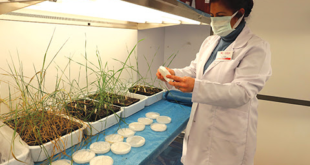Russia’s Great Investment in Genetics and Breeding
Posted by Nazimi Acikgoz on 23/06/2019
In an unexpected period, Russia announced that it has allocated a large amount of new breeding technologies[1]. According to information from the Russian Academy of Sciences (RAS), the targets of this US $ 1.7 billion investment of have been set to develop 10 new varieties of gene-edited crops and animals by 2020 and another set of 20 gene-edited varieties by 2027. The main aim of the project is to develop new varieties resistant to diseases in culture plants such as barley, sugar beet, wheat and
potato.
Mutation, selection, hybridization and similar classical breeding techniques have been used for breeding new genotypes that are adaptable to varying environmental conditions. Recently tissue culture, gene transfer and other molecular biologic developments have been also used. But in the last decades artificial mutations by using -X, gamma and similar radioactive rays- have served to plant breeders to breed thousands of new varieties. Mutation is a spontaneous or intentional change in living organism. Since 2010, this process has begun to be carried out in laboratories by molecular basis, with genomic arrangements. In this method, genotypes can be improved in a short time and reach the farmers. Gene regulation includes a number of new gene engineering methods such as CRISPR. In these methods, there is no transfer of any gene from outside like there is in GMOs. On the contrary, new genotypes are created by changing the target gene with the help of transient DNA-cutting enzymes. This application can increase or decrease the effect of gene. We can also call this process artificial micro-mutation.
GMOs are registered after passing through many risk tests such as environment and health before they are introduced to the consumers. Therefore, the cost of a genotype to the company exceeds US$ 100 million which is the main reason GMO and global multinational corporations have become synonymous. On the other hand the cost of developing genotypes with gene editing is almost 1/10th of GMO’s, therefore they can be utilized even by low-budget new startups, universities and even public institutions[2].
In 2018, the first commercial product of genome editing animal, tilapia developed with this new method was commercialized in Argentina[3]. It is the fourth most consumed sea product after shrimp, salmon and canned tuna. At the beginning of 2019, the oil of the new soybean variety[4], which was developed by the same method in the USA, took its place on the market shelves. The oil of this improved variety contains several times less “saturated fatty acids” and healthier oleic acid than ordinary soybeans.
However, the gene editing method was accepted by EU as GMO and in the year 2018 cultivation of the varieties improved with this technique have banned.
Russia, in 2016, had prohibited the cultivation of GMO crops, except research activities. And it has not been prepare yet any legal regulations on agricultural biotechnology.
Alexey Kochetov, director of the Siberian Branch of the Russian Academy of Sciences (RAS) Institute of Cytology and Genetics in Novosibirsk, lauded this new effort stressing that the country has been “chronically underfinanced” for decades. The research program also suggests that gene-edited products will be exempted from a law passed in 2016 that bans planting of genetically modified crops in Russia, except for research use.
Molecular geneticist Konstantin Severinov, who helped to develop the research program, is emphasizing the importance of CRISPR technology in making Russia less dependent on imported crops and is claiming: “Despite considering itself a bread basket, Russia is highly dependent on imports when it comes to elite crop varieties, so [the government decided] something needs to be done. Luckily, a few RAS members managed to make the case that CRISPRCas9 is a good thing”.
But whether Russian scientists can meet the program’s ambitious goals is unclear. Despite helping to develop the program, Severinov — who once famously described working in Russia as like “swimming in a pool without water” — says that it does not address the “inhumanely bad” conditions for doing life-sciences research in Russia, including red tape and poor access to supplies.
According to 2017 data, Russia devotes only 1.1% of GNP to scientific research, and it lags behind both China (2.1%) and the USA (2.8%).
This breakthrough of Russia is a striking example for seed industries of many countries. Let us first accept that gene editing technologies are inevitable for plant breeding. These techniques will cover greatly to plant breeder’s need for new gen material. Let’s take a look at how Germany has solved the issue of developing new genes – genotypes – varieties, material, which is the most important bottleneck for seed sector of almost every nation. Federal Ministry of Education and Research is responsible such issues. Ministry, within the framework of the GABI – Plant Genome Research Program -, support a macro project “PLANT 2030”, oriented to Germany’s plant research, on demands of private sector. GABI is a public-private joint project, with financial support coming mainly from the Ministry of Education and Research. WPG (Business Platform Promoting GABI Plant Genome Research e.V.) represents the private sector in Plant 2030.
This proves that improving gen material in molecular laboratories needs number of processes like communications with public and private plant breeders, making the necessary legal arrangements and preparing the research infrastructure. Actually it does not seem to be solved in a short time. In that case, is Konstantin Severinov right about his concerns mentioned above?
Prof. Dr. Nazimi Açıkgöz
 THE GLOBAL WINDOW OF TURKISH FOOD AND AGRICULTURE The Global Window of Turkish Food and Agriculture Sector
THE GLOBAL WINDOW OF TURKISH FOOD AND AGRICULTURE The Global Window of Turkish Food and Agriculture Sector








